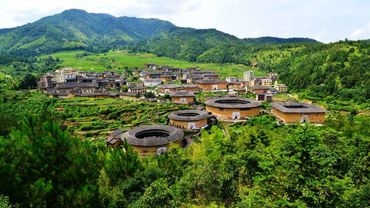One-day Tour of Fujian Hakka Fortified Earth Building (Tulou)
Highlights
- Explore the most extraordinary type of Chinese rural dwelling, the circular Hakka rammed earth buildings, otherwise known as the Fujian Tulou. Listed as a UNESCO World Heritage Site, it is some of the most amazing architecture you will ever see, and you’ll see life continue in the tulou as it has for hundreds of years
- For this tour you will have your own private guide and driver, which will ensure that your day is safe, fun, and hassle-free
Hakka Tulou Tour Itinerary
The Fujian Tulou is "the most extraordinary type of Chinese rural dwellings of the Hakka and others in the mountainous areas in southwestern Fujian. They were mostly built between the 12th and the 20th centuries. A tulou is usually a large, enclosed and fortified earth building, rectangular or circular in configuration, with very thick load-bearing rammed earth walls between three and five stories high and housing up to 80 families. Smaller interior buildings are often enclosed by these huge peripheral walls which can contain halls, storehouses, wells and living areas, the whole structure resembling a small fortified city.
From your hotel in Xiamen we will make the 2.5 hr drive to visit the tulou cluster of Tianluokeng, which is in Nanjing county. Tianluokeng Earth Buildings Complex is the Huang Family’s residence. The Earth Buildings are composed of one square building (Buyun Building), three circle buildings (Hechang Building, Zhenchang Building, and Ruiyun Building) and one oval building (Wenchang Building). The square building Fangyun Building sets in the middle while other four buildings surround it. The buildings scatter and interlock according to the lie of the mountains. If overlooked from a higher place, the buildings look like blooming plum blossoms embellished on the earth embraced by the mountains. While look up them from the foot of the mountains, it occupies a mountainside position, looking down the world like the Potala Palace. As a combination of exquisite constructions, Tianluokeng Earth Buildings Complex is a perfect landscape with the connection of cultural and natural elements and is acclaimed as the peak of perfection.
At the complex we will wander around and take a peek at the daily lives of these fascinating peoples. We will then head to drive to Yongding, where we will spend the night in an authentic Hakka earthen building village that is known as a tulou. The tulou has a shape of an emerging mushroom, or of a falling flying saucer. In the Cold War, it was even believed by the Western countries, when examining some tulous, that is was used as China’s nuclear reactor!
Afterward we will then proceed to the tulous of Yuchanglou. Yuchanglou is a five-story tulou located at Nangjing county Shuyang district Xiabanliao village. It was built in 1308 by the Liu family clan. It is one of the oldest and tallest tulou in China. Yuchanglou has been nicknamed the "zigzag building", because the vertical wooden post structure is not straight and perpendicular, but zigzags left and right. It was built that way due to an error measuring the building materials. But in spite of this apparent infirmity, this tall tulou withstood 700 hundred years of natural elements and social turmoil. Yuchanglou's outer ring is 36 m in diameter and boasts five stories, with 50 rooms on each floor. Each of the 25 kitchens on the ground floor at the back half of the circle has a private water well beside its stove. This is the only tulou in all of Fujian with such convenient water supply. There was a one story inner-ring house surrounding the ancestral hall as late as 2003. This part of the building stood nearly 700 years intact until, unfortunately, it was dismantled after 2003.
Then we will head to the “king of the tulou” at Chengqi Lou, which is located in Yongding county, and was built in 1709. Inscribed as a UNESCO World Heritage site in 2008, it is massive rotunda tulou with four concentric rings surrounding an ancestral hall at the center, the outer ring is 62.6 meters in diameter and four storeys tall, 288 rooms, with 72 rooms on each level, circular corridor on 2nd to 4th floor, with four sets of staircases at cardinal points connecting ground to top floors. A big roof extending out ward covers the main ring. The ground floor rooms are kitchens for family branches, the second level rooms are grain storage rooms, and the 3rd and 4th floor rooms are living quarters and bedrooms. The second ring of 80 rooms is two storeys high, with 40 rooms on each level, the third ring served as community library, one storey with 32 rooms; there are 370 rooms in all. The 4th ring is a circular covered corridor surrounding the ancestral hall. If a person stayed for one night in each room, it would take him more than a year to go through all the rooms. The ancestral hall is at the center. Chengqilou has two main gates and two side gates. 15th generation Jiang clan with 57 families and 300 people live here. At its heyday, there were more than 80 family branches lived in Chengqilou.
Other buildings in this cluster include: a three ring Shenyuanlou, outer ring 70m diameter; a Wujiaolou (pentagon) with irregular pentagonal floor plan and a rectangular tulou, the Shi-Ze lou.
After our visit to Chengqi Lou you will be drive back to your hotel in Xiamen, ending your tour.
Tulou and xianmen in china
Tulou Tour Pictures










REQUEST A TOUR
Copyright © 2003-2026 Great Wall Adventure Club - All Rights Reserved.
This website uses cookies.
We use cookies to analyze website traffic and optimize your website experience. By accepting our use of cookies, your data will be aggregated with all other user data.